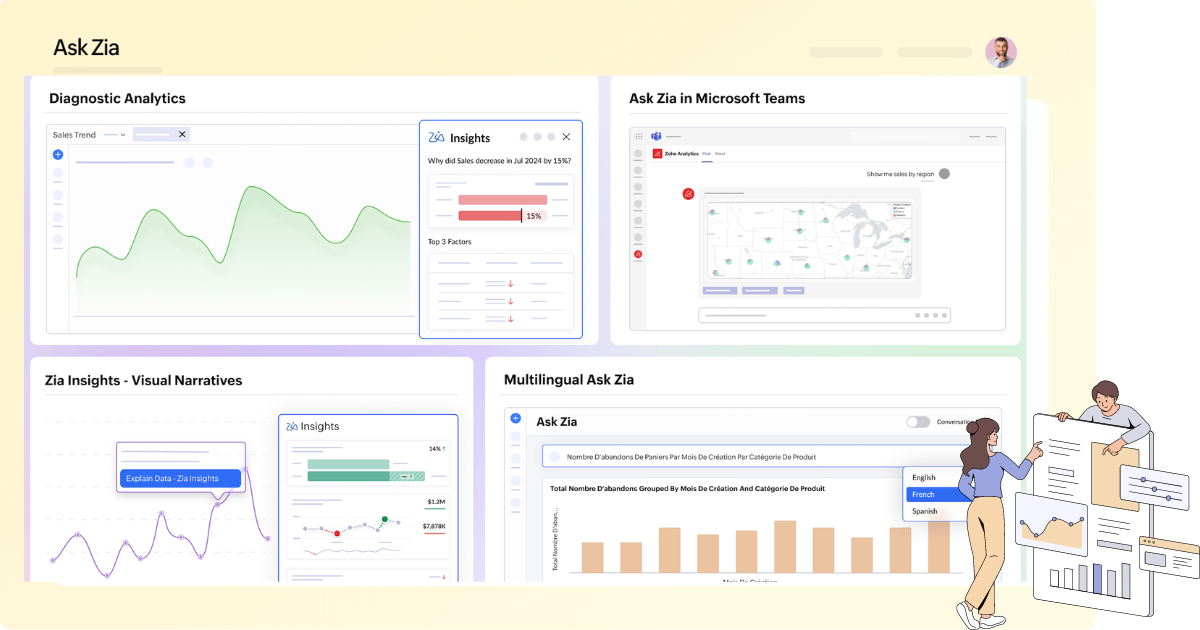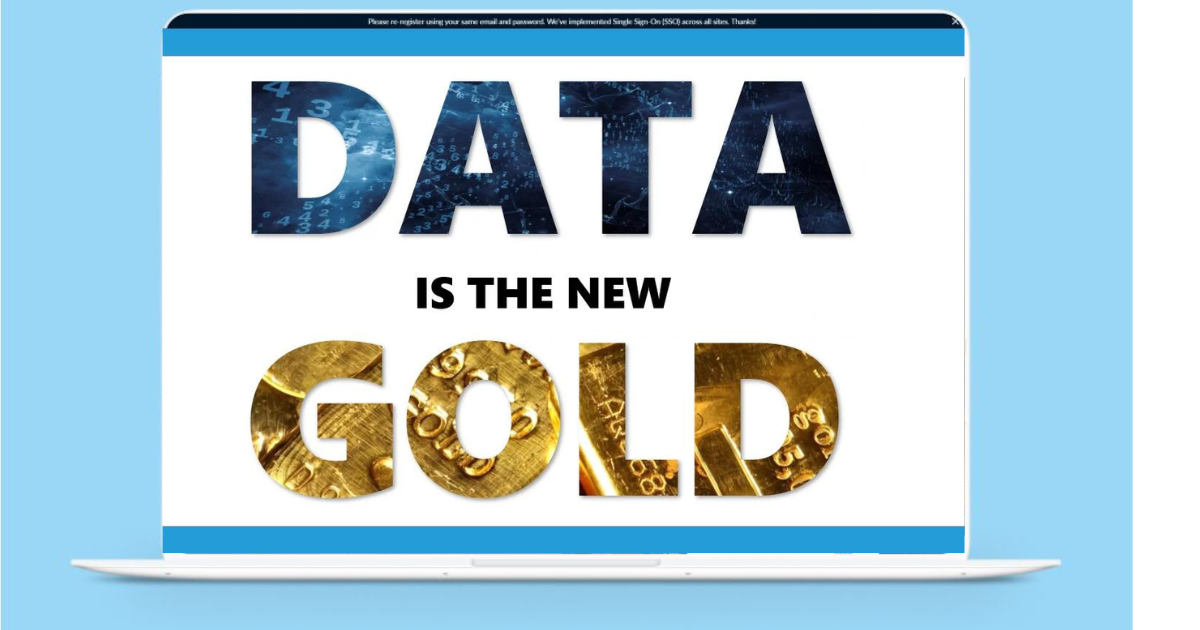How Zoho Analytics can Make Data Analysis Easier for You?
Data analysis can be overwhelming, especially when you're dealing with scattered data across multiple platforms. Find out how Zoho Analytics simplifies the data analysis process and empowers you to focus on making smarter, data-driven decisions for growing your business.

Have you ever felt like you're drowning in data, starving to get some useful insights from your data? You’re not alone.
Data is everywhere. You’ve got it coming from your CRM, your social media, sales figures, and website metrics. It sounds great to have all this information, right? But too many businesses get stuck in a flood of numbers and can’t figure out what really matters. That’s what we call data paralysis.
The stakes are high here. If you can’t make sense of all this data, decisions get delayed—or worse, you rely on gut feelings. This leads to missed opportunities, messy processes, and sometimes costly mistakes. Making decisions without clear insights is pretty scary.
That’s where Zoho Analytics steps in. It takes all that messy, raw data and turns it into simple, meaningful insights you can actually use. Think of it as a magnifying glass that helps you find that needle in the haystack. And it doesn’t just help you find it; it shows you why it matters.
By Implementing Zoho Analytics, you can navigate through your data confidently and make decisions that lead to real results.

Whether you're a small business owner or a seasoned data analyst, if you want to make smarter decisions and grow your business faster, Zoho Analytics is a must-have. Give it a try, and you'll be amazed at how much easier data analysis can be.
In this blog post, I’ll guide you through how Zoho Analytics simplifies data analysis, making it practical for any business to draw valuable insights and make smarter decisions. Plus, we’ll look at how Business Intelligence (BI) infused with Generative AI in Zoho Analytics can further elevate your data analysis capabilities.

How Is Data the New Gold? (But Only If You Know How to Mine It)
Data is often referred to as the new gold, but just like mining gold, getting the valuable nuggets out of a mountain of rock requires the right tools. Without proper analysis, your data is just numbers sitting in a database, offering no real value.
Imagine having access to all the answers to your business challenges, but they’re written in a language you can’t read. That’s what it feels like when you have all the data but no way to make sense of it.

Picture this: you have all the answers to your business problems, but they're written in a language you can't understand. That's what it's like when you have tons of data but no clue how to make sense of it.
Think of data as a puzzle. The pieces—your raw data—are scattered everywhere. You need to fit them together to see the big picture. That’s where Zoho Analytics comes in. It’s like the cover of a puzzle box, showing you what the final picture looks like and helping you connect the pieces the right way.
Why You Should Use Zoho Analytics for Your Data Analysis Needs?
If you're navigating the vast ocean of data, Zoho Analytics is like your trusty compass, steering you toward clarity and insight. Imagine trying to piece together a jigsaw puzzle in the dark—overwhelming, right? That’s what handling data without the right tools feels like.
Zoho Analytics illuminates your data landscape, allowing you to effortlessly sift through information like a master chef selecting the finest ingredients for a gourmet meal. With its intuitive interface and advanced analytics capabilities, it transforms raw data into digestible insights, helping you make informed decisions faster without breaking a sweat.
And here’s the best part: the advanced AI assistant, Zia, offers helpful suggestions. It helps you explore your data in ways you might not have considered before.
So, whether you're a small business or a large enterprise, using Zoho Analytics is like having an on-demand data analyst who can help you gain valuable insights into your business and make better-informed decisions.
How Does Zoho Analytics Make Data Collection and Analysis Easier for Smart Decision-Making?
Have you ever made a major business decision solely relying on your gut instinct, only to regret it later?
While it can be a good idea to trust your intuition for making most life choices, relying solely on it for all business decisions may prove to be an expensive mistake. Data-driven decision-making involves using factual information and analytics to guide business strategies. This approach reduces the likelihood of errors by providing evidence-based insights, leading to more accurate and effective outcomes.
Simplify Your Data Analysis with Zoho Analytics for Better Insights
Let’s see how Zoho Analytics simplifies data analysis for taking better business decisions:
1.Break Down Silos with Unified Data
One of the most frustrating things about data analysis is that your data often comes from multiple sources. Sales data might live in Zoho CRM, marketing metrics in Google Analytics, and financial data in QuickBooks. Piecing it all together feels like juggling too many balls in the air.
Zoho Analytics solves this by integrating with a variety of platforms, meaning you can pull all your data sources into one place. No more bouncing between different systems to track sales trends, customer behaviors, and financial performance.
Example: Let’s say you’re running an ecommerce business. You have sales data in Zoho CRM, web traffic insights in Google Analytics, and marketing campaign performance in Zoho Campaigns.
Individually, these data sets tell you part of the story, but when you bring them together using Zoho Analytics, you get a comprehensive view of which campaigns are driving traffic, how that traffic is converting into sales, and what your customers are doing on your site.
This unified approach allows you to see that a specific email campaign drove 30% more traffic to your site, with a conversion rate that doubled compared to the previous month. Now, you know which campaigns work, why they work, and where to focus your efforts.
2. Visualize Data Like a Pro with Custom Dashboards
Let’s face it—most folks don’t get excited about sifting through endless rows of numbers. It’s tough to pull out useful insights from raw data when it’s just sitting there in its plain form. That’s why visualization is so important. Zoho Analytics has a bunch of data visualization like graphs, charts, heat maps, and dashboards that turn data into something you can actually use.
Think about it this way: Data is like a heavy book. Trying to read every single word can be draining. But if someone hands you a slick infographic that highlights the main ideas, everything becomes clearer. Zoho Analytics is like that infographic-maker, turning complicated data into easy-to-read visuals, so you can spot trends, outliers, and insights in a snap.
Here’s a real-world example: A SaaS company uses Zoho Analytics to create a custom dashboard that tracks user behavior, customer acquisition costs, and churn rates. By visualizing their data, they discovered a pattern: customers who used a particular feature in the first week were twice as likely to stick around for more than six months. Armed with this knowledge, they tweaked their onboarding process to guide users toward that feature, significantly reducing churn.
3. Automate your data analysis through powerful yet simple reports.
Have you ever spent hours putting together data reports? It can feel like a never-ending task. You’re not just gathering numbers; you’re also trying to make sense of them in a way that everyone can understand. It’s a real time-sucker, right?
Well, with Zoho Analytics, you can wave goodbye to those long hours. You can set up automated reports that give you the insights you need without all the fuss. Once you’ve got it running, these reports can show up daily, weekly, or monthly—whatever fits your needs.
Here’s how it works: Imagine you’ve set Zoho Analytics to pull in daily sales data from Zoho CRM and website stats from Google Analytics. Every morning, you get an automated report that tells you:
- How many visitors checked out your site?
- Which products were flying off the shelves?
- How much revenue did you bring in?
No more pulling data by hand. No messy spreadsheets. Just a clean, up-to-date report ready for your morning meeting.
This automation cuts down on human mistakes and makes sure you're always working with the most accurate info. Plus, it gives you back precious time. Now you can focus on what really matters—your strategy—instead of getting lost in report-making.
4. Advanced Analytics Without Needing a Data Scientist : From Complex Reports to Predictive Insights
Not every business has a data science team or the budget to hire one. But here’s the good news: Zoho Analytics makes advanced analytics accessible to everyone. It offers features like predictive analytics, AI-powered insights, and even lets you ask questions in plain language. You don’t need a PhD in statistics to start spotting trends in your data.
Many businesses focus on what happened in the past. Sure, that’s important, but the real advantage comes from looking ahead. With Zoho Analytics, you can leverage machine learning to predict future trends based on what you’ve already experienced. Think of it like having a crystal ball that reveals where your business might be headed and the challenges that could pop up along the way.
Zoho Analytics is great for understanding the past, but it really shines in helping you forecast what’s coming next. Its predictive analytics features let you:
- Spot trends early
- Identify potential risks
- Discover opportunities before they become obvious
For Example: A retail chain used Zoho Analytics’ predictive analytics to forecast sales for the upcoming quarter. Based on historical data, customer behaviors, and seasonal trends, the AI model predicted a 15% dip in sales for a particular product line. This allowed the company to adjust its marketing strategy and inventory, avoiding excess stock and unnecessary costs.
5. Improved Collaboration with Shared Reports and Dashboards across your Teams and Clients
Data isn’t just for analysts or big bosses. It’s for everyone on the team. With Zoho Analytics, you can easily share reports and dashboards with your teammates. This way, collaboration flows smoothly between departments. Whether you're in marketing or customer service, everyone gets the insights they need to do their jobs better.
Think of it like a puzzle. Instead of each person having just a piece, everyone works on the complete picture together. When the whole team has the right data, they can make smarter decisions. And that leads to better results for everyone.
Let’s look at a quick example of teamwork across departments:
Say you’re a marketing manager who just launched a new ad campaign. You can share real-time reports with your sales team to show how many leads the campaign is bringing in. Meanwhile, your customer support team can see which products are getting the most inquiries.
This kind of transparency helps everyone stay ahead of the game. Sales can tweak their pitches, and support can prepare for a spike in tickets. It's all about working together effectively!
6. Advanced Analytics for Power Users
Here’s the thing: Zoho Analytics is user-friendly for everyone, but it doesn't forget about the power users. If you're more technically inclined, you'll love the advanced features.
You can dive into SQL queries, create custom functions, and blend data in complex ways to craft detailed reports and analyses.
Here’s an example: Imagine you’re a financial analyst at a big company. You want to create a tailored report that pulls in data from several databases. You can apply your own calculations and even generate a detailed financial forecast. Pretty neat, right? With Zoho Analytics, advanced users have all the tools to explore really and understand their data.
7. Business Intelligence Infused with Generative AI
Incorporating Generative AI into Zoho Analytics takes data analysis to the next level. Generative AI leverages machine learning to analyze large datasets and generate new insights, patterns, and forecasts that traditional analytics might miss. This integration enhances decision-making by providing more nuanced and accurate predictions.
Example: Imagine a financial services firm using Zoho Analytics with Generative AI to predict market trends. The AI can analyze historical financial data, economic indicators, and news articles to generate accurate forecasts and risk assessments. This helps the firm make more informed investment decisions and stay ahead of market changes.
How we leveraged Zoho Analytics to Enhance Decision-Making Across Industries
No matter what industry you’re in, data analysis plays a critical role in decision-making. Let’s explore how businesses from different sectors have benefited from our Zoho Analytics Implementation.
Retail: Optimizing Inventory and Sales Strategies
Retailers deal with massive amounts of data—inventory levels, sales trends, customer preferences, and more. Zoho Analytics helps by centralizing all this data and providing actionable insights.
For example, a fashion retailer used Zoho Analytics to keep an eye on their seasonal sales. They looked at past data to see which products flew off the shelves during certain months. This way, they could buy smarter and avoid having too much or too little stock.
What did they achieve? They cut down their unsold inventory by 20% and boosted their overall sales by 15%. That’s a win-win!
Healthcare: Streamlining Patient Care and Operations
In healthcare, data isn’t just about business—it’s about patient care. Zoho Analytics can help healthcare providers track patient outcomes, streamline operations, and improve the overall quality of care.
Example: A hospital used Zoho Analytics to analyze patient data from different departments. They identified that patients who waited longer for lab results were more likely to leave negative reviews. By addressing the bottleneck in their lab operations, they reduced wait times and saw a noticeable improvement in patient satisfaction scores.
SaaS: Tracking User Engagement and Reducing Churn
For SaaS companies, data is crucial for understanding user behavior, optimizing product features, and reducing churn. Zoho Analytics makes it easy to track these metrics in real time.
Example: A SaaS company noticed a drop in engagement for a recently introduced feature. Using Zoho Analytics, they tracked user behavior and found that the feature was difficult to access in the app’s interface. By making a small UI adjustment, they saw a 30% increase in usage of the feature, leading to higher customer retention.
Making Data-Driven Decisions: A Practical Approach
So, how can you make the most of Zoho Analytics in your business?
Here’s a practical approach to getting started:
- Identify Key Metrics: Begin by identifying which metrics matter most to your business. Is it sales growth, customer acquisition cost, or user engagement? Focus on the numbers that directly impact your business goals.
- Integrate Your Data Sources: Connect Zoho Analytics to all relevant platforms, whether it’s your CRM, social media, financial software, or marketing tools. This will give you a unified view of your business data.
- Customize Your Dashboards: Create custom dashboards that show the data you care about. Use visualizations like charts and graphs to make it easy to spot trends and outliers.
- Set Up Automated Reports: Automate your reporting so you can get regular updates without lifting a finger. Schedule these reports to be sent directly to your inbox or to team members who need the data.
- Leverage AI-Powered Insights: Use the AI features in Zoho Analytics to discover hidden trends or make predictions about future performance. Even if you’re not a data expert, these tools can help you make smarter decisions.
Final Thoughts
Data is like gold—valuable but only if you know how to dig it out. Zoho Analytics makes it easy for businesses of all sizes to analyze their data without getting lost in the numbers.
As your business grows, so does the amount of data you collect. The great thing about Zoho Analytics? It scales with you. Whether you're working with a few thousand data points or millions, this platform adapts, so you always have the insights you need.
It pulls together data from different sources, offers smart analytics, and lets you customize how you visualize your data. This means you can turn raw information into real, actionable insights. Plus, with Generative AI added into the mix, you get even deeper insights to help steer your decisions.
Feeling overwhelmed by data? You don’t have to be. With Zoho Analytics, you can simplify things. This means you'll make better decisions, and you’ll do it faster and with more confidence.
Ready to turn your data into a strategic asset?
Our team of Zoho Analytics experts at YAALI is here to help you unlock its full potential. Let us guide you through the implementation process, tailor Zoho Analytics to your specific needs, and create custom dashboards that provide actionable insights.
Don't miss out on the opportunity to make data-driven decisions that drive your business forward.
Contact us Now to schedule a consultation and learn more about how Zoho Analytics can benefit your organization.
Share this Post if you think this blog post is useful😊
💌 Get Early Access to our Exclusive Content by Subscribing to our Email List😲
Join over 1250+ Zoho enthusiasts & Business Owners who receive our email newsletter directly in their inbox.


